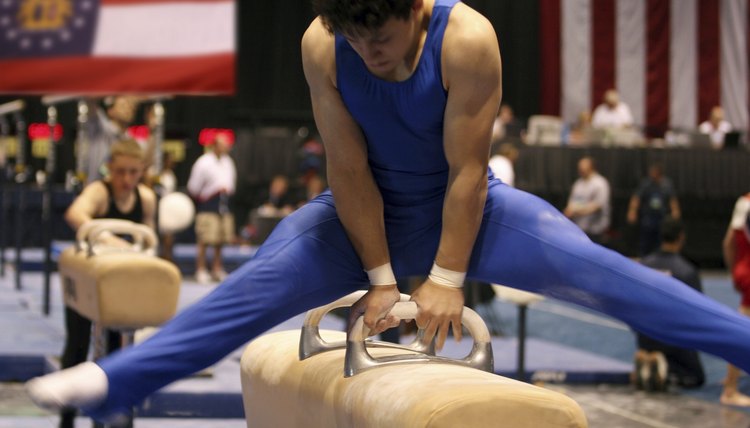Types of Gymnastics Vaults

The vault is an event in both men’s and women’s artistic gymnastics. Performing a successful vault involves power, speed and proper technique. During a gymnastics competition, gymnasts are judged on execution and level of difficulty. More difficult vaults are worth more points than easier vaults. In 2001, the original vault was replaced with the vaulting table, after the International Federation of Gymnastics deemed it safer than the original apparatus.
Handspring Vault
During a handspring vault, the gymnast runs toward the vault, jumps onto the springboard with both feet and places both hands on the vault. Once the gymnast pushes off his hands, he can perform a variety of twists, flips and maneuvers. Sample handspring vaults include a front handspring with a one-and-a-half twist and a Cuervo, a front handspring with a half-twist into a back tuck. The Rudi vault involves a handspring front entry into a front flip with one and a half twists.
Yurchenko
The Yurchenko vault is named after Russian gymnast, Natalia Yurchenko, the 1983 World Gymnastics Champion. When performing a Yurchenko vault, a gymnast runs toward the vault and performs a round-off cartwheel onto the springboard. The gymnast then mounts the vault from a back handspring position. A series of twists, flips and other maneuvers are performed once the gymnast’s hands hit the vaulting table. Yurchenkos are blind-entry vaults and often include single or double full-twisting layouts.
Yurchenko With Twist
The newest category of vaults involves a Yurchenko entry, which involves a round-off onto the springboard and a half-turn or more before mounting the vaulting table. From the mount, a gymnast then performs single or full twists and front or back flips. An example of the Yurchencko with a twist is the Khorkina, named after Russian gymnast, Svetlana Khorkina. The vault includes a Yurchenko with a twist entry into a piked back flip. The Khorkina can be performed from a tucked or layout position.
Tsukahara Vault
Like the handspring vault, a gymnast performs a Tsukahara vault by running toward the springboard and jumping on with both feet. Before mounting the vault, however, the gymnast does a half-twist and mounts the vault backwards. The Phelps is a Tsukahara vault that includes a half-turn after the mount into a front layout. The Tsukahara is named after Japanese gymnast and five-time Olympic gold medalist, Mitsuo Tsukahara.
Judging Criteria
When scoring the vault, judges look for five elements: run, springboard, table, flight and landing. Gymnasts are judged not only on the trick performed on the vault but also the run required to get there. Judges also critique the gymnast’s technique as she jumps from the springboard to the vault. Correct body positioning during this phase indicates that the gymnast has control of the trick. Judges evaluate the gymnast’s push off the vault by watching form, shoulders and momentum. Evaluation of the trick itself is called flight, the term used for the gymnast’s performance in the air. The final element of the vault is called the landing. Judges expect gymnasts to stick the landing and deduct points for bobbles, steps or stepping outside the boundary.
References
Writer Bio
Adrienne Weeks spends her time as a collegiate speech instructor, fitness instructor and stay-at-home mom. She holds a master's degree in communication studies from Texas Tech University. Weeks has written about a wide variety of topics but enjoys sharing her passion about fitness, cooking and parenting.
